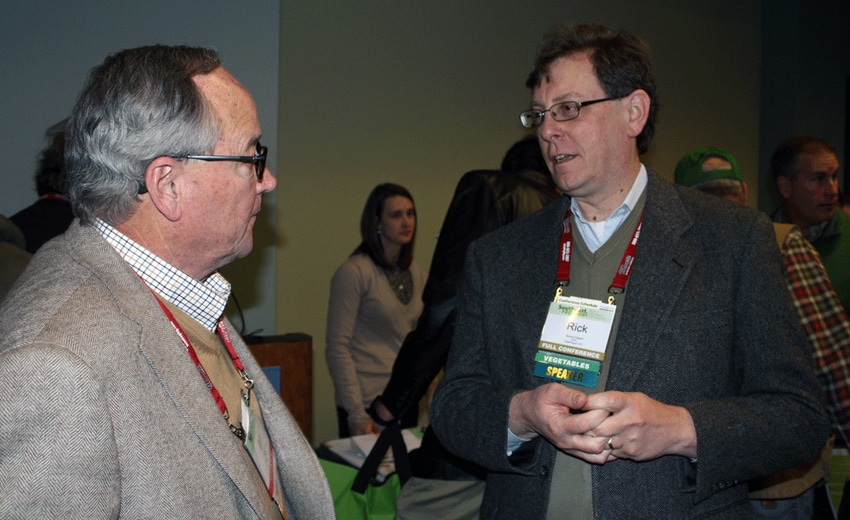
Calculating soil fumigant buffer zones the right way
The Environmental Protection Agency in 2009 began to phase in new regulations for soil fumigant applications. Fumigant labels were introduced requiring stricter safety measures, including buffer zones.The Soil Fumigant Toolbox is a web-based resource developed to help fumigant applicators navigate what can be 100- to 200-page labels now attached to fumigant products.

Soil fumigant labels changed in Dec. 2012, requiring applicators to calculate and stick to buffer zones around fields when applying fumigants. A lot of work by the Southeast vegetable industry and the Environmental Protection Agency went into basing the buffer zones’ distances on sound science. And a “toolbox” has been developed to help vegetable growers stay in bounds with the regulations.
High-value crops like vegetables are susceptible to soil diseases, insects, nematodes and weed competition. Prior to planting, growers apply soil fumigants, or gases, to sterilize beds, which are typically wrapped in plastic mulch. They do this to protect against plant-damaging pathogens and to produce vegetables as economically as possible.
After the fumigants’ presence has dissipated enough, vegetables are then planted into the plastic-wrapped bed. This practice has resulted in dramatic yield increases and improved produce quality in the last three decades, and has allowed the Southeast vegetable industry to grow and stay competitive.
The Environmental Protection Agency in 2009 began to phase in new regulations for soil fumigant applications. Fumigant labels were introduced requiring stricter safety measures, including buffer zones. According to EPA, “A buffer zone provides distance between the application site (i.e., edge of field) and bystanders, allowing airborne residues to disperse before reaching the bystanders. This buffer will reduce the chances that air concentrations where bystanders are located will cause acute adverse health effects.”
The “buffer zone period” starts when any fumigant is dispensed to the soil within an application block or greenhouse. The period lasts for a minimum of 48 hours after the fumigant’s application.
The Soil Fumigant Toolbox is a web-based resource developed by the Environmental Protection Agency to help fumigant applicators navigate what can be 100- to 200-page labels now attached to fumigant products, said Rick Keigwin, director of EPA��’s Pesticide Re-evaluation Division, talking to a vegetable session at the Southeast Regional Fruit and Vegetable Conference on Jan. 9.
The basic idea behind the buffer zone calculator is to let growers, or soil fumigant applicators, enter three or four numbers and play with different scenarios to determine a required buffer zone for a particular fumigant, helping them work their way through the buffer zone requirements. This tool is specific to each fumigant product and is based on the look-up tables on product labels.
For example, the calculator can help figure this out: an applicator applies metam sodium by shank injection to beds at the broadcast equivalent rate of 75 gallons per acre to an application block that is 120 acres. What is the buffer zone? It’s 129 feet.
Soil fumigant applications can qualify for buffer zone reduction credits, which can reduce buffer zone distances, by using specific application practices such as tarps highly impermeable to soil fumigant or they can modify application parameters. The buffer zone calculator can help them figure out those credits.
At one point prior to the phasing in of the buffer zones requirements for new labels, the buffer zones for some products were recommended to be as much as half a mile around a field. This was not workable for growers. Few vegetable fields, especially in the Southeast, are that far away from residences.
Keigwin said land-grant Extension specialists, growers and fumigant manufacturers worked together to develop the science-based data EPA needed to drop significantly the buffer zone requirements and at the same time protect bystanders and still give growers workable real-world guidelines.
“And to me that is a good example of how we can work with you and partner with you and you can continue to grow your crops,” Keigwin told the 150 growers, Extension specialists and industry reps during the session. “I know that’s not what some people think EPA is about but that is what I think EPA is about -- helping you continue to grow your crops.”
Until supplies run out, soil fumigant products with older labels can still be applied.
About the Author(s)
You May Also Like





